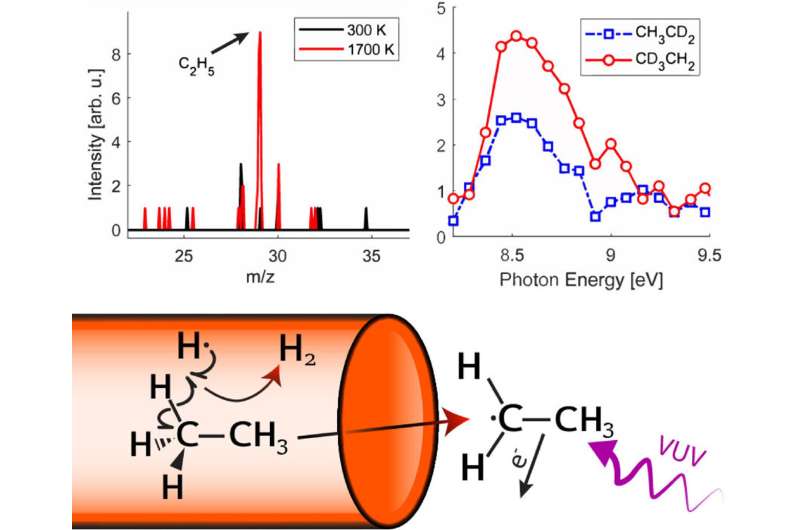This article has been reviewed according to Science X's editorial process and policies. Editors have highlighted the following attributes while ensuring the content's credibility:
fact-checked
peer-reviewed publication
trusted source
proofread
Scientists observe driver of chemical reaction in plastics industry for first time

Now, here is a strange thing. One of the most important drivers of perhaps the largest industrial chemical reaction has never been observed in over 100 years of study.
Reactions of three related molecules—ethane, ethyl, and ethylene—are the key factors in producing hundreds of millions of tons of plastic and other industrially important chemicals annually. These chemical reactions are central to both producing plastics and the combustion of natural gas, yet researchers have only been able to theorize about how they work by analyzing final products, because most experiments are unable to observe short-lived chemical intermediates, despite their importance in driving such reactions.
Now, Ben-Gurion University of the Negev scientists have detected the last unobserved intermediate in the ethane pyrolysis reaction for the first time. With these findings, those reactions could become more efficient—producing more products with less material, byproducts, pollution, and energy.
Their findings, with their US and Swiss colleagues, were published recently in Angewandte Chemie.
"Observing this intermediate is the beginning of the path to making associated processes cleaner and more efficient, an important factor in industries such as plastics and natural gas," says corresponding author Dr. Josh Baraban. His Ph.D. student Nadav Genossar-Dan led the theoretical and practical aspects of the experiment, originally designed to target ethylidene, an elusive radical closely related to ethane and ethyl.
"At first, I didn't know what we had done," admits Genossar-Dan, "it was only when I was looking at the data we collected that I realized we had managed to observe this important chemical."
"Going back through the literature since the 1930s, I couldn't find a single researcher who had managed to observe it," he added.
Genossar-Dan designed a flash pyrolysis experiment—heating the molecule until it cracks apart, for very short times (a tenth of a millisecond). But he needed a synchrotron (an unusual tool based on an electron accelerator of which there are only a few dozen in the entire world), which can be used to produce vacuum ultraviolet light.
He managed to book a one-week experiment in the Swiss Light Source synchrotron, and then worked around the clock with three of his group members and the hosting scientist to run the experiments. Because they are so rare, synchrotrons run 24/7 and researchers must apply for permission to use them.
Genossar-Dan's modeling explained the experiments and the findings completely. Now it is up to others to follow them.
In the end, the demanding work, both designing and running the experiment, paid off as they made chemistry history.
More information: Nadav Genossar‐Dan et al, Direct Observation of the Ethyl Radical in the Pyrolysis of Ethane, Angewandte Chemie International Edition (2023). DOI: 10.1002/anie.202305881
Journal information: Angewandte Chemie International Edition , Angewandte Chemie
Provided by Ben-Gurion University of the Negev





















